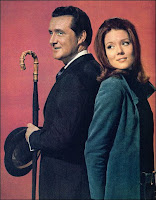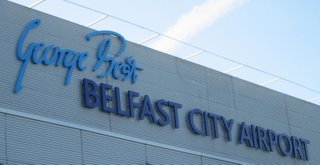
On Thursday night I went along to Yorkgate Moviehouse (in the process of being renamed City Side) to see Hunger before it comes to the end of its run in the local cinemas.
I don’t really go to the cinema to be entertained. Not every time. Life would be saccharine-coated if all literature, films, radio and TV was about making me chuckle. Thought-provoking and eye-opening is good too.
Hunger is an unusual film. Really a series of vignettes strung together. Slow and stark, sparse dialogue and completely devoid of a musical score. Yet the film’s all about tone, observing these snapshots of life ... and death. You know the story before it starts. Well, you know the ending. But anyway, be warned: spoilers ahoy!
So we watch the morning routine of Raymond, a prison officer, leaving home on a crisp winter morning, checking under his car while his wife watches anxiously out the living room window. Smoking in shirt sleeves outside in the snow. A new IRA prisoner Davey arrives, refusing to wear prison uniform, and discovering the reality of the dirty/no wash protest. Long lingering gazes around the cell, taking in the "artwork" ... that I wonder whether director Steve McQueen had a hand in? The pile of rotting leftover food and the maggots in the corner of the cell, a hiding place for contraband that would never be disturbed by the prison staff.
While Dolby smell-o-vision has thankfully not been installed in Belfast cinemas, the stench of the cell was obvious.

Now I’m not liberal enough to expect a holiday camp atmosphere for incarcerated terrorists and murderers. And in an establishment that runs by discipline and control, there has got to be some authorities reaction to prisoners refusing to obey the local rules – whatever the ins and outs of the situation. And if prisoners struggle and kick out then they will be held tightly.
But the sheer brutality surprised me. Being hauled out of a cell and knocked out against the wall. The bath time scene was perhaps the worst. Prison officers in riot gear, with plastic shields and truncheons, beating prisoners as they headed down to have orifices and mouths checked for illicit goods (in that order with the same gloved finger) before being hurled into a bath and scrubbed with a brush.
The dirty protest following on from the first hunger strike was obviously an extraordinary time. But if the portrayal is at all accurate – and I don’t hear anyone or any organisation claiming that the scenes written by Enda Walsh and Steve McQueen weren’t realistic – then humanity and dignity of both the prisoners and the prison officers had all but vanished.
Throughout the film, there was a sense of loneliness. The featured prison officer, Raymond, had little relationship with his colleagues. It couldn’t have been an easy place to work. And it must have marked people for life, destroying their optimism, killing their soul. Weekly mass was about the only time the prisoners got together – mostly spending the time chatting, planning and encouraging each other, rather than listening to the words of the priest. There was a beautiful scene of a prisoner interacting with a fly on the cell’s window grill, trying to get it to walk over his hand. A human being seeking companionship from where he could get it - a pet fly.
There are two deaths in the film. One is the murder of an off-duty Raymond – eleven prison officers died during the period of the two hunger strikes and the dirty protest.

The other death – Bobby Sands – takes up the second half of the film. There’s a change of pace for a while as Bobby meets his priest. Much has been made in the media about the twenty minute unbroken scene as Michael Fassbender (Sands) and Liam Cunningham (priest) sit opposite each other in the visiting room. It’s unrushed and in keeping with the rest of the film. There’s humour and banter, as they chew the cud and talk about the pressures of having more than one priest in the family.
As the priest goes about his “business of the soul”, Sands presents his pitch for the prisoners’ next step. Having been promised their own clothes, the prisoners were presented with clown outfits. The republican leadership on the outside isn’t going to win the battle for the prisoners inside. And whereas everyone joined the first failed hunger strike at the same time (and consequently all got weaker at the same time), Sands explains that the second one will be more organised. Starting at two week intervals, with a knowledge that it will be the relentless build-up of death that will bring about change. When challenged by the priest that he’s really planning suicide, Sands rationalises it against a “pure” cause and a sense that it will provide freedom.
The final stages of the film strangely bring back a warmer sense of humanity. The medical orderlies tending to an emaciated Sands. Putting lotion on his sores. A sheepskin rug under the sheet. Fresh food appearing at meal times to be ignored. Eventually building a cage around him on which to rest the blanket. BJ Hogg appears – must be in the contract when you get money from NI Screen! – and slightly bursts the bubble. But there’s gentleness and compassion for the first time in the film. In the final days, Sands’ parents move into a nearby room. And many tears filling up in eyes across the cinema.
Sands died after 66 days without food. Nine prisoners died on that second hunger strike.
So a film about being trapped – whether in a job or a call. About being lonely and isolated. About suffering. And a film about endurance – whether sticking in a job, following an ideology, or watching your child starving themselves to death.
Hunger is the first British film to win the Caméra d'Or (for best first feature film) at the Cannes film festival. There’s some beautiful camera work ... without falling into the trap of being too obviously artsy. And a graininess to the print – lines running up the middle of the screen for most of the film – not sure whether that was Yorkgate’s print or a deliberate effect? And unfortunately, the image wasn’t centred on the screen at Yorkgate screen 7, with a good 8-12 inches being projected off the left hand side of the screen – which really affected the symmetry that had been so carefully set up in the long Sands/priest dialogue.
I was living in Lisburn – not far from the Maze – and in P4 when all this happened. My memory is not of the hunger strike itself, nor of Sands being elected as MP for Fermanagh and South Tyrone, but of the black flags tied to the telegraph poles as we drove across to Westport for a holiday that summer.
So I’m glad I took the opportunity to go and see Hunger before it leaves the big screen. A bit like the recent Breakout documentary on BBC NI, it fills in a bit of history that was missing, a whether it’s totally accurate is less of an problem for me. And I wouldn’t judge it to glorify the IRA prisoners, nor the prision service. It’s one story, amongst many. And maybe I’ll hear some of the others being told in the coming years to fill out the story.




































